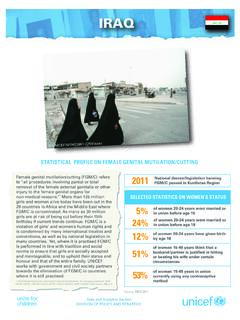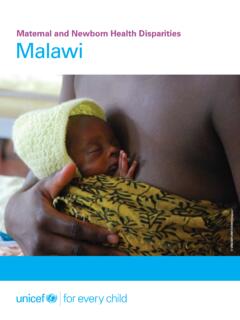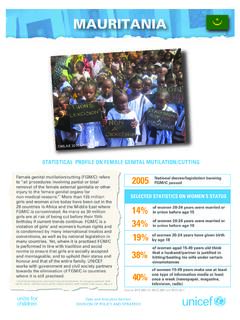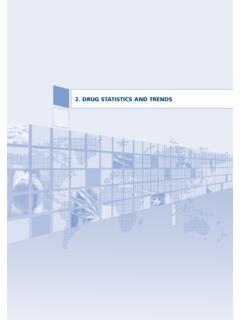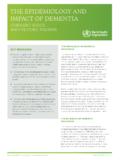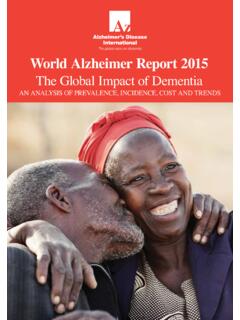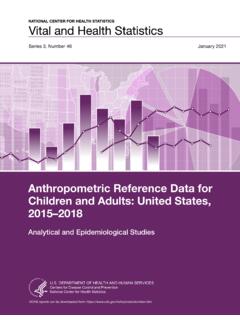Transcription of Child Marriage Data Brief - UNICEF DATA
1 Latest trends and future prospectsChild Marriage2I Child Marriage - Latest trends and future prospectsThe practice of Child Marriage has continued to decline around the world. Based on the latest data available from each country, 21 per cent of young women (aged 20 to 24) were married as children. This represents a decrease from 25 per cent 10 years ago, driven predominantly by progress in India. This reduction also marks an acceleration of trends . An estimated 25 million Child marriages have been prevented due to progress during the past decade. Of these, 7 million were expected based on the prior trends and 18 million were due to an acceleration of , approximately 650 million girls and women alive today were married before their 18th Marriage is an egregious violation of every Child s right to reach her or his full potential.
2 The Sustainable Development Goals (SDGs) enshrine a target to eliminate this practice by OVERVIEW UNICEF /UNI159928/KHANAs the designated custodian agency for monitoring progress towards reaching this target, UNICEF is responsible for generating periodic global estimates of Child Marriage . These estimates are produced primarily from nationally representative household surveys, and for a minority of countries, from census data. The estimates in this document supersede those in previous publications, as they rely on new data for a number of countries. These include India and Ethiopia, which have recently seen a decline in the prevalence of Child Marriage , and China, for which data were previously not available in UNICEF s global databases.
3 These updates have enabled a refinement of the estimation of the magnitude of the practice worldwide, at a slightly lower level than estimated in previous Marriage - Latest trends and future prospects ISouth Asia285 million, 44%Sub-Saharan Africa115 million, 18%East Asiaand Pacific75 million, 12%Other Regions80 million, 12%Latin America and Caribbean60 million, 9%Middle East and North Africa35 million, 5%Observed overpast 25 overpast 10 for eliminationby 203023%MILLIONOf these, 7 million were expected based on the prior trendsAnd 18 million were due to an acceleration of progress. 25 million Child marriages have been prevented due to progress in the past decadeYet a substantial acceleration would be required in order to eliminate the practice by 2030 Average annual rate of reduction in the prevalence of Child Marriage , observed and requiredSouth Asia is still home to the largest number of Child brides, followed by sub-Saharan AfricaGlobal distribution of the number of women first married or in union before age 18, by regionNOTE: Due to rounding, individual figures may not add up to the global practice of Child Marriage has continued to decline around the world.
4 During the past decade, the proportion of young women who were married as children decreased by 15 per cent, from 1 in 4 (25%) to approximately 1 in 5 (21%).The global number of Child brides is now estimated at 650 million, including girls under age 18 who have already married, and adult women who married in Child Marriage - Latest trends and future prospectsREGIONAL TRENDSD espite a marked reduction in Child Marriage , especially in South Asia, no region is on track to eliminate the practice by 2030 Percentage of women aged 20 24 years who were first married or in union before age 18, by regionNOTE: Projected values are calculated on the basis of observed trends over the past ten years. For further details on the data, see the Technical Notes trends in the practice of Child Marriage are evident across geographical regions, though variations exist within regions and even within countries.
5 In South Asia, a girl s risk of marrying in childhood has declined by more than a third, from nearly 50 per cent a decade ago to 30 per cent today, largely driven by great strides in reducing the prevalence of Child Marriage in India. Nonetheless, South Asia remains home to the largest total number of Child brides, with more than 40 per cent of the global burden. This is due both to the legacy of how common Child Marriage was in previous generations and to the region s large , however, the global burden of Child Marriage is shifting from South Asia to sub-Saharan Africa. In sub-Saharan Africa, levels of Child Marriage have declined at a modest rate. In West and Central Africa in particular, the region with the highest prevalence of Child Marriage , progress has been among the slowest in the world.
6 At the same time, population growth threatens to result in an ever-higher number of Child brides in sub-Saharan Africa during the coming years. Latin Americaand CaribbeanSouth Asia West andCentral AfricaEastern andSouthern AfricaMiddle East andNorth AfricaEastern Europeand Central AsiaWorldEast AsiaTODAY10 YEARS AGO25 YEARS AGOPROJECTED 2030 VALUE60 50 40 3020 100%3041351725117215 Child Marriage - Latest trends and future prospects IIn order to meet the target of elimination by 2030, global progress would need to be 12 times faster than the rate observed over the past the most recently married Child brides globally, close to 1 in 3 are now in sub-Saharan Africa, compared to 25 years ago when the proportion was 1 in 7.
7 Yet progress is possible. In Ethiopia, once among the top five countries for Child Marriage in sub-Saharan Africa, the prevalence has dropped by a third during the past 10 years. In the Middle East and North Africa, substantial progress in reducing the prevalence of Child Marriage has occurred over the past 25 years. Within the past 10 years, however, this progress appears to have Latin America and the Caribbean, there is no evidence of progress, with levels of Child Marriage as high as they were 25 years of Child Marriage remain low in East Asia and the Pacific and in Eastern Europe and Central Asia, though girls from disadvantaged populations are still at the global reduction in Child Marriage is to be celebrated, no region is on track to meet the SDG target of eliminating this harmful practice by 2030.
8 UNICEF /UNI43945/HEAVENST hirteen-year-old Mulu Melka lives with her parents in a rural area in the southern Oromia Region. She has twice evaded forced Marriage - once by escaping an abduction and once by insisting on an HIV test - and is determined to finish school. Mulu s insistence on being educated, echoed by community leaders, has convinced her father to support her. Girls need to be educated so they can be self-reliant and know how to protect themselves, says Mulu. She plans to be a Child Marriage - Latest trends and future prospectsData sourcesUNICEF global databases include Child Marriage estimates for 125 countries, primarily from nationally representative household surveys such as the Multiple Indicator Cluster Survey (MICS) and Demographic and Health Survey (DHS).
9 Of these, 106 countries have estimates that are recent enough (2010 to 2016) to be included in the present analysis. These countries represent 63 per cent of the global population. (For a summary of data availability by region, see the table on the next page.)Demographic data are from the United Nations Department of Economic and Social Affairs Population Division, World Population Prospects: The 2017 revision (DVD Edition).Calculation of global figuresTo assess the prevalence of Child Marriage , this analysis used SDG indicator the percentage of women aged 20 to 24 years who were first married or in union before age 18. This information is available from data collection instruments, primarily household surveys that ask respondents about their marital status and their age at first Marriage or union.
10 All references to Marriage include both formal marriages and informal unions in which women started living together with a partner as if current global estimate of the prevalence of Child Marriage , referred to as the level today , is calculated on the basis of the latest available data for each country, within the span of 2010 to 2016. National values are not extrapolated to a common reference year. UNICEF /UN013090/LYONTECHNICAL NOTESThe global burden of Child Marriage is defined as the number of girls under age 18 who have already married plus the number of adult women who were married before age burden is calculated by applying the prevalence of Child Marriage for each age cohort from 18 to 49 years to the respective female population.
